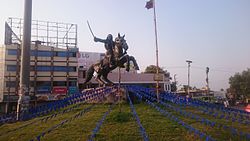Hubli
|
Hubballi ಹುಬ್ಬಳ್ಳಿ |
|
|---|---|
| City | |
| Hubballi | |

Hubli
|
|
| Nickname(s): Chota Mumbai, Twin cities, Hubballi-Dharwad | |
| Location of Hubli | |
| Coordinates: 15°21′42″N 75°05′06″E / 15.36167°N 75.08500°ECoordinates: 15°21′42″N 75°05′06″E / 15.36167°N 75.08500°E | |
| Country |
|
| State | Karnataka |
| Government | |
| • Mayor | Smt Manjula R Akkur |
| Area | |
| • Total | 806.48 km2 (311.38 sq mi) |
| Elevation | 671 m (2,201 ft) |
| Population (2011) | 2,541,980 |
| • Rank | 50 |
| • Density | 2,300/km2 (5,900/sq mi) |
| Time zone | IST (UTC+05:30) |
| Pincode(s) | 580001 - 580064 (incl. Dharwad west end) |
| Area code(s) | +91-836 |
| Vehicle registration | KA 25 (Dharwad RTO) KA 63 (Gabbur RTO) |
| Official language | Kannada |
| Website | http://www.hdmc.mrc.gov.in |
Hubli, officially known as Hubballi is the second largest city in Karnataka. It forms continuous urban area with the city of Dharwad.
Hubli-Dharwad is the largest conurbation in the state after capital Bangalore and is located 85 kilometres south of Maharashtra-Karnataka border.
The name Hubballi literally means "Flowering creeper" in Kannada. While Dharwad is the administrative headquarters, the city of Hubli, situated about 20 km south-east of Dharwad, is the commercial centre and business hub of North Karnataka region. Crops including cotton, chilly and peanuts are grown aplenty in the surrounding rural agricultural areas, and Hubli is a major trading centre for these commodities. It is also an important city for the Indian Railways, as it is the headquarters for South Western Railway Zone and the Hubli Railway Division. Hubli is a major railway junction in North Karnataka. It is also the headquarters of North Western Karnataka Road Transport Corporation.
Hubli also houses the largest number of government offices outside Bangalore, Hubli-Dharwad is selected for Solar City / Green City Master Plans
"Hoovina Balli" became Hubballi Rayara Hubli, also called 'Eleya Purvada Halli' or 'Purballi' was the old Hubli, where there is a Bhavani Shankara temple and Jaina basti. Under Vijayanagara Rayas, Rayara Hubli grew as a commercial centre, famous for trade in cotton, saltpetre and iron. Under the rule of the Adilshahis, the British opened a factory here. The factory was looted by Shivaji in 1673. The Mughals conquered Rayara Hubli and it was then placed under the governance of the Nawab of Savanur, who built a new extension named Majidpura. Later, trader Basappa Shettar built new Hubli around the Durgadabail (fort maidan) part of Rayara Hubli.
Hubli's famous Moorusavira Matha is claimed to have been established by a Sharana of Basaveshwara's period. Hubli was conquered by the Marathas from the Nawab of Savanur in 1755-56. In the following years, Hubli was conquered by Hyder Ali, only to be recaptured by the Marathas in 1790. At this point in time the old town was administered by a person named Phadke under the Peshwas and the new town was under the administration of the Sangli Patwardhan. The British took Old Hubli from the Peshwas in 1817. The new town, with 47 other villages, was handed over to the British by the Sangli Patwardhan in lieu of subsidy in 1820. Later in 1880, the British started the Railway workshop and with this, Hubli came to be reckoned as an industrial centre in this part of India.
...
Wikipedia


